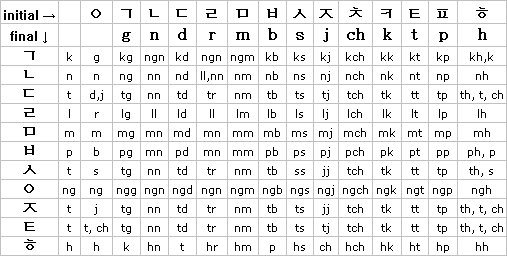Korean Romanization
Romanization is the translation of sounds of a foreign language into English letters. Romanization of Korean words allows those who can't read Korean to phonetically pronounce it. Below are two tables showing the Romanization rules for transliterating from Korean to English:
Consonants


Vowels


Running sounds together
In the table below, note the resulting sound of the ending character on a syllable (final) and the beginning character on the following syllable (initial).

Rules in Brief
- When ㅅ is followed directly by ㅣ, it should be Romanized as shi.
Example: 다시 (again) would be dashi. - To avoid confusion of syllables, a hyphen can be used.
Example: 후에 (after) would be hu-e. - When ㄱ, ㄷ, ㄹ, ㅂ are found directly before vowel, they are Romanized as g, d, r, b.
- When ㄱ, ㄷ, ㄹ, ㅂ are found directly before a consonant, they should be Romanized as k, t, r, p.
If you would like more in-depth information on Romanization rules, read more here.
Too much to remember? Use our Romanizer!